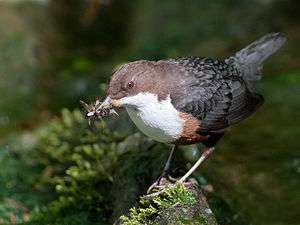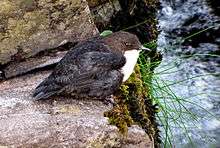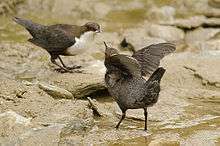White-throated dipper
| White-throated dipper | |
|---|---|
 | |
| In Scotland | |
| Scientific classification | |
| Kingdom: | Animalia |
| Phylum: | Chordata |
| Class: | Aves |
| Order: | Passeriformes |
| Family: | Cinclidae |
| Genus: | Cinclus |
| Species: | C. cinclus |
| Binomial name | |
| Cinclus cinclus (Linnaeus, 1758) | |
 | |
| Resident Winter[2] | |
The white-throated dipper (Cinclus cinclus), also known as the European dipper or just dipper, is an aquatic passerine bird found in Europe, Middle East, Central Asia and the Indian Subcontinent. The species is divided into several subspecies, based primarily on colour differences, particularly of the pectoral band. The white-throated dipper is Norway's national bird.[3]
Taxonomy and systematics
The dipper was first described as Sturnus cinclus by Carl Linnaeus in 1758.[4] The genus and species name cinclus derives from the Greek word kinklos that used to describe small tail-wagging birds that resided near water.[5] There are 13 extant and extinct subspecies for the dipper:[6][7]
C.c. cinclus 'Black-bellied Dipper' (Linnaeus, 1758) Scandinavia, western France, northwestern Spain, Corsica, Sardinia, and a migrant and infrequently travels to the British Isles from Shetland to Kent.
C.c. gularis 'British Dipper' (Latham, 1801). England, Wales, and Scotland excluding western regions and the Hebrides.
C.c. hibernicus 'Irish Dipper' (E. Hartert, 1910). Ireland and Western Scotland including the Hebrides
C.c. aquaticus 'Southern European Dipper' (Bechstein, 1797). Central and southern Europe, ranging from Belgium, eastern France and Spain toward Greece, Poland and Sicily.
C.c. minor 'Northwest African Dipper' (Tristam, 1870). Mountainous terrain of Algeria, Tunisia, and Morocco.
C.c. caucasicus 'Caucasus Dipper' (von Madarász, 1903). Caucasus mountains ranging to Iran, Iran, and Turkey. Winters in Afghanistan and Pakistan.
C.c. persicus 'Persian Dipper' (Witherby, 1906). Southwest Iran in the Zagros and Bakhtiari mountains.
C.c. rufivrentris 'Lebanon Dipper' (Tristam, 1884). Anti-Lebanon mountains.
C.c. olympicus 'Cyprus Dipper' (von Madarász, 1903). Formerly in the Troodos mountains in Cyprus; currently extinct. Last recorded in 1945, and almost certainly extinct by 1958.
C.c uralensis 'Ural Dipper' (Serebrovski, 1927). Ural Mountains.
C.c. leucogaster 'White-bellied Dipper' (Bonaparte, 1850). Northern Afghanistan through Central Asia toward Eastern Siberia.
C.c. cashmeriensis 'Cashmir Dipper' (Gould, 1860). Himalayas from western Kashmir to Sikkim.
C.c. przewalskii 'Przewalskii Dipper' (Bianchi, 1905). Mountains of southern Tibet and western China
C.c. baicalensis (Dressen, 1892). No detailed georgraphy given.
Description
The white-throated dipper is about 18 centimetres (7.1 in) long, rotund and short tailed. The head of the adult (gularis and aquaticus) is brown, the back slate-grey mottled with black, looking black from a distance, and the wings and tail are brown. The throat and upper breast are white, followed by a band of warm chestnut which merges into black on the belly and flanks. The bill is almost black, the legs and irides brown. C. c. cinclus has a black belly band.
The young are greyish brown and have no chestnut band.
Behaviour and ecology

The white-throated dipper is closely associated with swiftly running rivers and streams or the lakes into which these fall. It often perches bobbing spasmodically with its short tail uplifted on the rocks round which the water swirls and tumbles.
It acquired its name from these sudden dips, not from its diving habit, though it dives as well as walks into the water.
It flies rapidly and straight, its short wings whirring swiftly and without pauses or glides, calling a shrill zil, zil, zil. It will then either drop on the water and dive or plunge in with a small splash.
From a perch it will walk into the water and deliberately submerge, but there is no truth in the assertion that it can defy the laws of specific gravity and walk along the bottom. Undoubtedly when entering the water it grips with its strong feet, but the method of progression beneath the surface is by swimming, using the wings effectively for flying under water. It holds itself down by muscular exertion, with its head well down and its body oblique, its course beneath the surface often revealed by a line of rising bubbles.
In this way it secures its food, usually aquatic invertebrates including caddis worms and other aquatic insect larvae, beetles, Limnaea, Ancylus and other freshwater molluscs, and also fish and small amphibians. A favourite food is the small crustacean Gammarus, an amphipod shrimp. It also walks and runs on the banks and rocks seeking terrestrial invertebrates.
The winter habits of the dipper vary considerably and apparently individually. When the swift hill streams are frozen it is forced to descend to the lowlands and even visit the coasts, but some will remain if there is any open water.
Breeding

The nest is by the water. It is large, globular or oval, like a large wren's nest, built into a crack or hollow in the rock, in the masonry, or on the supports of a bridge, or, more rarely, in an overhanging branch. It is composed of moss, dead grass and leaves. This ball, however, is just a shelter. Usually hidden beneath a lip, is the entrance to the real nest within, a cup of grass or sedge, nearly as large as the nest of a blackbird, lined with leaves of oak, beech or other trees. Three to six white eggs are laid starting between March and May. One or two broods are reared, usually in the same nest.
When disturbed, the young that hardly feathered will at once drop into the water and dive.
Voice
The male has a sweet wren-like song. During courtship the male sings whilst he runs and postures, exhibiting his snowy breast, and when displaying he will take long and high flights, like those of the common kingfisher, accompanied by sharp metallic calls clink, clink, different from the normal zil.
References
- ↑ BirdLife International (2012). "Cinclus cinclus". IUCN Red List of Threatened Species. Version 2013.2. International Union for Conservation of Nature. Retrieved 26 November 2013.
- ↑ Brewer, David (2001). Wrens, Dippers and Thrashers. Pica Press. ISBN 978-1-873403-95-2.
- ↑ "Norges nasjonalfugl fossekallen" (in Norwegian). Norsk Rikskringkasting AS. Retrieved 19 January 2011.
- ↑ Linnaeus, C. (1758). Systema Naturae per Regna Tria Naturae, Secundum Classes, Ordines, Genera, Species, cum Characteribus, Differentiis, Synonymis, Locis. Tomus I. Editio Decima, Reformata (in Latin). Holmiae: Laurentius Salvius. p. 168.
- ↑ Jobling, James A. (2010). Helm Dictionary of Scientific Bird Names. Bloomsbury Publishing. p. 107. ISBN 9781408133262.
- ↑ Brewer, David (2001). Wrens, Dippers, and Thrashers. Yale University Press. pp. 199–202. ISBN 978-0-300-09059-8.
- ↑ "White-throated Dipper Cinclus cinclus (Linnaeus, 1758)". Avibase. Retrieved 14 April 2015.
External links
 Media related to Cinclus cinclus at Wikimedia Commons
Media related to Cinclus cinclus at Wikimedia Commons Data related to Cinclus cinclus at Wikispecies
Data related to Cinclus cinclus at Wikispecies- Cinclus cinclus in the Flickr: Field Guide Birds of the World
- "Cinclus cinclus". Avibase.

- White-throated Dipper videos, photos & sounds on the Internet Bird Collection
- Ageing and sexing (PDF; 1.9 MB) by Javier Blasco-Zumeta & Gerd-Michael Heinze
